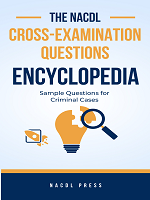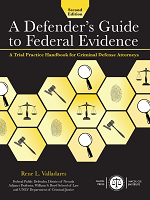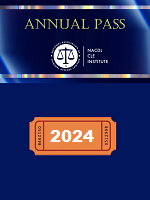Access to The Champion archive is one of many exclusive member benefits. It’s normally restricted to just NACDL members. However, this content, and others like it, is available to everyone in order to educate the public on why criminal justice reform is a necessity.
In his separate opinion criticizing the breadth of the majority’s language, Justice White described Justice Douglas’s opinion in Brady v Maryland1 as creating “in constitutional form a broad rule of criminal discovery.”2 Sadly, White’s caricature of the majority’s opinion was not to be vindicated. To the contrary, for 50 years defense lawyers have had to fight to make the critically important Due Process right affirmed in Brady meaningful for their clients. Part of this struggle was a decade-long effort to incorporate Brady’s disclosure obligation into the discovery provisions of the Federal Rules of Criminal Procedure. That campaign reached a frustrating conclusion in 2007, when the amendment came within a few votes of success in the Federal Judicial Conference Standing Committee on Rules of Procedure, after narrowly passing the Advisory Committee on Criminal Rules. The failure of that effort led NACDL to turn its energies to a new strategy: codifying the Brady rule, for federal cases at least, in the form of a statute.
NACDL’s objective, of course, was not to codify post-Brady case law and practices. Despite becoming a powerful tool for justice in countless cases, the Brady doctrine from the first has faced resistance. In addition to outright violations, the decision was — and continues to be — narrowly and begrudgingly interpreted by most prosecutors and many courts. As a result, NACDL created a task force to devise a model statute that would supplement the rules of procedure, while overturning the key misinterpretations of Brady and unwarranted restrictions that have arisen. Timing was to prove fortuitous: The NACDL Board of Directors adopted the task force’s proposal on May 20, 2011.3 Less than a year later, the United States v. Stevens scandal created an occasion for the introduction by Sen. Lisa Murkowski (R. Alaska) and a bipartisan group of five co-sponsors on March 15, 2012, of S. 2197, the Fairness in Disclosure of Evidence Act. As introduced, S. 2197 was based almost entirely on the NACDL proposal. While the bill died in committee with the end of the 112th Congress, it will be reintroduced in the new Congress, and NACDL will press for passage.
The Fairness in Disclosure bill does not attempt to reform criminal discovery generally, but it does seek to clarify and implement the Brady rule in each respect that case law development has made problematic over the years. Among these issues are the pervasive misuse of the term “exculpatory” to define the doctrine’s focus, the insertion of a “materiality” requirement, application of the doctrine to preliminary matters, interaction with “Jencks Act” (Rule 26.2) restrictions and CIPA, whether disclosable material must constitute “evidence,” the matter of timing (including the problem of guilty plea cases), the related questions of defense diligence and prosecutorial “suppression,” waiver and enforcement, including remedies for noncompliance, and the standard of appellate review.
‘Favorable’ Versus ‘Exculpatory’
First, the proposed Act would correct two major misinterpretations of the Brady principle that have crept into the case law and popular understandings. The Act would eliminate any suggestion that the doctrine’s coverage is limited to information that can be described as “exculpatory,” in the sense of “exonerating.” The Brady majority itself never used the term “exculpatory” to describe the limits of its concern. Instead, it referred to material which “would tend to exculpate [the accused] or reduce the penalty,”4 using the term “favorable” three times to capture the essential characteristic of the covered material.5 It was only Justice White’s separate concurring opinion, expressly criticizing the majority for going too far in its holding, which used the expression (and even then, just quoting the Maryland Supreme Court’s opinion) “material evidence exculpatory to an accused.”6
As has been frequently noted, the Justice Department guidance on Brady obligations, as well as much of the case law, generally understates the prosecutor’s obligations in this regard. The Act remedies that misunderstanding by defining “covered information” broadly as including matters that “may reasonably appear to be favorable to the defendant.”7 The error in the Justice Department’s overly limited focus on “exculpatory evidence” is apparent from the fact that Brady was itself a sentencing case. The undisclosed information in Brady was a prior statement by the cooperating co-conspirator that was relevant only to whether the jury would choose to impose a death sentence (was it John Brady or his cooperating co-defendant Donald Boblit who strangled the victim of the robbery-murder they admittedly committed together?8). The narrow holding in the Supreme Court, after all, was actually unfavorable to John Brady: that he was entitled on Due Process grounds to a remand for resentencing only, as the Supreme Court of Maryland had held, and not to a new trial, as he contended. The Act thus makes explicit that favorable information is disclosable even if it is not “exculpatory” at all, as long as it may be favorable to the defendant “with respect to … the sentence to be imposed.”9
A further innovation of the Fair Disclosure Act is the express extension of the Brady doctrine to “preliminary matters,” in addition to the issues of guilt and punishment. In other words, information favorable to the defendant with respect to issues bearing on a detention hearing, a suppression motion, or the like would now be unambiguously covered. Case law on the subject is sparse and inconsistent.
Abandoning the ‘Materiality’ Standard
The other most common obstruction to proper Brady disclosure is prosecutors’ insistence that the rule only applies to “material” information, that is, information creating a reasonable probability, by itself, of changing the outcome of the proceedings by producing an acquittal or a lower sentence. This interpretation comes from an inappropriate transference of the standard for reversal after conviction, or for a grant of habeas relief, to become the standard for disclosure before trial.10 Articulating a statutory rule to govern pretrial disclosure, the Act abandons the “materiality” standard entirely. No one can reliably say, before the fact, what effect a given piece of information might have on the investigation of a case, or predict its overall impact on a jury; there is no reason the rule should encourage prosecutors, as the “materiality” limitation does, to withhold evidence in the necessarily ill-informed belief (or hope) that the effect would be minor. (This viewpoint also sometimes misleads prosecutors into holding back information that seems to them to lack credibility or to be otherwise unpersuasive.) Under the proposed Act, if the information “may reasonable appear to be favorable,” it must be disclosed, without any attempt to predict in advance whether its nondisclosure would change the outcome of the case.
Covered ‘Information,’ Not Evidence
Another unduly restrictive reading of the Brady doctrine that has crept into practice, but which would be overthrown by the proposed legislation, is based on a literal reliance on the Supreme Court’s use of the term “evidence” in its own summary of its holding, which refers to “evidence favorable to the accused.”11 There is nothing in the purposes of the Brady due process doctrine to tie it with admissibility; leads to favorable information and material useable only on cross-examination are just as important. Moreover, a limitation to admissible evidence would be inconsistent with the Act’s application (as it is with the Brady doctrine’s application) to sentencing, where the rules of evidence do not apply.12 Accordingly, the Act does not speak in terms of “evidence” (except in its title, as a kind of shorthand) but rather defines “covered information” as “information, data, documents, evidence or objects” without further limitation.13
Disclosure Without Delay
Because the Brady disclosure obligation has never been codified in the federal discovery rules,14 the question of timing for required disclosures had to be addressed in the Act. Case law has been unhelpful, speaking of disclosure in time to be useful, which in effect has been taken by many prosecutors as encouraging them to seek advantage by waiting until the last possible moment. The Act tackles this problem head on by making disclosure obligatory “without delay after arraignment and before the entry of any guilty plea.”15 No triggering demand by the defense is made a prerequisite to the prosecutor’s duty. Later-discovered information would have to be disclosed “as soon as is reasonably practicable upon the existence of the covered information becoming known, without regard to whether the defendant has entered or agreed to enter a guilty plea.”16
If the prosecutor perceives a need for relief from the prompt disclosure requirement, the Act allows an application for a protective order. Thus, if information is favorable to the accused only because of its impeachment value, and early disclosure would endanger the witness who made the statement (and if no defendant already knows the identify of that witness), then the government may seek a protective order until a date nearer to trial, but generally not less than 30 days prior to the scheduled trial date. Proceedings to obtain a protective order could be conducted under seal, but not ex parte, with disclosure to defense counsel in the form of a summary.17
Interaction With Jencks Act
This prompt-disclosure requirement under the Act would also overcome the bogus interpretation of Brady that has sometimes led prosecutors to claim, or judges to rule, that the restrictions of the Jencks Act18 and/or Fed. R. Crim. P. 26.2 prevent disclosure of Brady material contained in statements of a witness until the witness has completed his or her direct examination. The Act expressly provides that its timing rule applies notwithstanding these other provisions.19
Defense Due Diligence
Another aspect of Brady case law that is peculiar to the appellate context in which precedent is made, but which has been inappropriately imported into some courts’ and prosecutors’ views of how the disclosure obligation should be carried out before trial, is the notion that the defense must have exercised its own due diligence in seeking out favorable evidence. Under the Act, by contrast, prosecutors are not excused from their disclosure duties by any notion that the defense could find out the same information by undertaking a more energetic defense investigation. Such thinking is simply irrelevant to whether the prosecutor has a duty of disclosure. Relatedly, the Act would be violated by a failure of required disclosure, without regard to whether that nondisclosure could be described as “suppression” of the covered information. That the Supreme Court did not mean to limit the due process right to cases of “suppression” as contrasted with nondisclosure20 is clear from the Court’s pointed inclusion in its stated holding of the phrase, “irrespective of the good faith or bad faith of the prosecution.”21 In any event, the Act imposes no such requirement.
Waiving Brady Rights
The Act as drafted seeks to discourage efforts by the government to evade its protections by routinely seeking waiver of statutory Brady rights in plea agreements. While the drafting task force considered attempting to prohibit such waivers, the group felt that position was not achievable, and clearly the NACDL Board agreed when it adopted the report. Thus, while the Act would allow its provisions to be the subject of a knowing, intelligent and voluntary waiver,22 two unusual protections are included. First, a Brady waiver, to be valid, must be entered into “in open court.”23 And second, the judge must find that “the interests of justice require the proposed waiver.”24 As few if any other provisions of a plea agreement require such special attention and endorsement from the court, the Act should be read as disapproving routine inclusion of such provisions, even though the Supreme Court allows them.25
Remedies and Appellate Review
If a violation of the Act is discovered prior to the entry of judgment, the Act provides a show-cause procedure for the trial court to make inquiry into the alleged violation, and then to make appropriate findings.26 Upon a finding of noncompliance, the court can order any of an array of appropriate remedies, tailored to the nature and circumstances that it may find, ranging from a continuance to dismissal.27 Upon finding a violation, the court also has discretion to order recovery of excess defense costs, including attorney’s fees. An award of attorney’s fees is to be without regard to the terms of any fee agreement (that is, even if the attorney has been paid a flat fee) and can be ordered paid to a Defender Organization or the CJA Fund.28
The Act ends with a section on the standard of appellate review. Since the Act is intended to implement a constitutional right, the law if enacted would provide that a violation could not be found harmless on appeal unless the government can meet the standard that applies to constitutional violations — harmlessness beyond a reasonable doubt.29 Following the lead of the NACDL task force, the proposed legislation does not address any other issues concerning enforcement of the Brady right on appeal, or in postconviction proceedings. Nor does the Act address the question of when, if ever, the prosecutor’s Brady obligation may cease while a case remains open, or even after it is closed.
Written Rules Required
If Brady v. Maryland had been embraced by prosecutors over the last 50 years as a reminder that the objective of the criminal justice system is to see that the process is fair, that truth is pursued, and that justice is done, and if judges had interpreted, developed, and applied Brady’s principle accordingly, there would be no need for regulatory implementation. But in the real world, written rules are needed. Procedural issues governing court cases are almost always better addressed in the rulemaking process than in legislation. But having been let down by the Judicial Conference with respect to implementation of Brady, NACDL will continue to push for a legislative solution. Perhaps enough members of Congress, having seen the tragic results of massive Brady violations in the ill-considered prosecution of one of their own, will rally around the Fairness in Disclosure of Evidence Act and ensure that it is enacted this year.
Notes
- 373 U.S. 83 (1963).
- Id. at 91 (separate opinion of White, J., concurring in the judgment).
- The task force proposal was drafted principally by Mark Mahoney, Peter Goldberger, and Irwin Schwartz, with valuable input from Ellen Yaroshefsky and others.
- 373 U.S. at 88 (emphasis added).
- Id. at 86-87.
- Id. at 91.
- S. 2197 (112th Cong.), § 2 (creating proposed new 18 U.S.C. § 3014(a)(1)).
- See 373 U.S. at 88.
- Proposed § 3014(a)(1)(C).
- As articulated by the Supreme Court in Brady itself, affirming the judgment of the Maryland Supreme Court, “We now hold that that the suppression by the prosecution of evidence favorable to the accused upon request violates due process where the evidence is material either to guilt or to punishment, irrespective of the good faith or bad faith of the prosecution.” 373 U.S. at 87. This is the stated standard for reversal on appeal, not the articulation of a pretrial disclosure rule to govern prosecutors.
- 373 U.S. at 87.
- See Fed. R. Evid. 1101(d)(3) (Evidence Rules do not apply at sentencing, except rule with respect to privileges); see also 18 U.S.C. § 3661; 21 U.S.C. § 850 (information admissible in aid of sentencing without limitation, except on constitutional grounds).
- Proposed § 3014(a)(1). The Act does provide, however, that covered material which would be subject to the Classified Information Procedures Act is to be handled under the provisions of the latter law. Id. § 3014(d)(2).
- It has been argued persuasively that most if not all Brady material should be understood as covered by the Fed. R. Crim. P. 16(a)(1)(E)(i) obligation to disclose “papers” and other “tangible objects” (including “portions of” these) that are “material to preparing the defense.” Unfortunately, most prosecutors and judges do not seem to agree with that reading of the existing Rule.
- Proposed § 3014(c)(1). This obligation, insofar as it refers to guilty pleas, would supersede the adverse Supreme Court decision in United States v. Ruiz, 536 U.S. 622 (2002).
- Proposed § 3014(c)(2).
- Id. (e).
- 18 U.S.C. § 3500.
- Id. (d)(1). The make this doubly clear, the Act provides for a conforming amendment to the Jencks Act. S. 2197, § 3(b). The contrary “Jencks-trumps-Brady” view is transparently wrong in any event, since Brady is a constitutional rule, while Rule 26.2 (or the Jencks Act) is merely statutory in weight. Subsection (d)(1) was necessary in the Act, however, not only to remove any excuse for withholding Brady material in supposed reliance on the Jencks Act but also because the early-disclosure provision in subsection (c)(1), to the extent deemed merely statutory, would not necessarily have greater authority than the Rule 26.2. See also 28 U.S.C. § 2072(b) (Rules Enabling Act, describing relationship of Rules and statutes on matters of procedure).
- See note 9 ante (quoting Supreme Court’s use of term “suppression” in its statement of the holding in Brady).
- 373 U.S. at 87.
- Proposed § 3014(f)(2)(A).
- Proposed § 3014(f)(1).
- Proposed § 3014(f)(2)(B).
- See United States v. Ruiz, 536 U.S. 622, 629 (2002).
- Proposed § 3014(g).
- Proposed § 3014(h)(1).
- Proposed § 3014(h)(2).
- Proposed § 3014(i).






